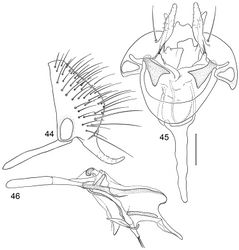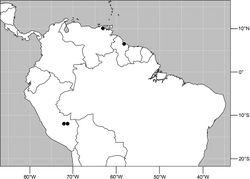Planinasus venezuelensis
| Notice: | This page is derived from the original publication listed below, whose author(s) should always be credited. Further contributors may edit and improve the content of this page and, consequently, need to be credited as well (see page history). Any assessment of factual correctness requires a careful review of the original article as well as of subsequent contributions.
If you are uncertain whether your planned contribution is correct or not, we suggest that you use the associated discussion page instead of editing the page directly. This page should be cited as follows (rationale):
Citation formats to copy and paste
BibTeX: @article{Mathis2012ZooKeys225, RIS/ Endnote: TY - JOUR Wikipedia/ Citizendium: <ref name="Mathis2012ZooKeys225">{{Citation See also the citation download page at the journal. |
Ordo: Diptera
Familia: Periscelididae
Genus: Planinasus
Name
Planinasus venezuelensis Hennig – Wikispecies link – Pensoft Profile
Description of male
Moderately small to medium-sized flies, body length 2.35–3.10 mm.
Head: Frons mostly bare of microtomentum, shiny, except for densely microtomentose, velvety-appearing, anterolateral angles, blackish brown; frons much wider than long, frontal ratio 0.40–0.45; interfrontal seta long, length subequal to that of lateral vertical seta. Scape and pedicel blackish brown except for whitish yellow, ventral projection of pedicel; pedicel with ventral projection long, about 1/2 length of basal flagellomere; basal flagellomere long, slightly more than twice basal width, yellowish; arista bearing 13–14 dorsal rays, 3–4 ventral rays. Face variable, wide to very wide (at least of male), facial ratio 0.85–1.25; dorsal 2/3 (above transverse carina) wide, shield-like, medial portion (between antennal bases) moderately densely microtomentose, mostly whitish but with blackish brown background coloration also appearing, lateral portion (just below antennae) bare, shiny, especially ventrally, and with ventral margin of antennal grooves quite evident; ventral 1/3 of face (below transverse facial carina) mostly densely microtomentose, somewhat shiny, whitish to whitish yellow, with blackish, somewhat bare, narrowly triangular area extended obliquely medioventrally from ventral margin of antennal groove; large facial setae 3, not arranged in transverse rows, becoming smaller ventrally; largest facial seta inserted dorsolaterally, dorsoclinate and convergent; 2nd largest seta inserted medioventrally from largest seta, porrect and parallel; 3rd seta inserted ventrolaterally and with porrect to slightly ventroclinate. Clypeus and palpus blackish brown. Gena concolorous with ventral 1/3 of face.
Thorax: Generally dark colored, black to blackish brown, anepimeron paler, brownish, with ventral margin yellowish; mesonotum thinly invested with microtomentum, appearing subshiny, with slightly metallic brown luster medially, becoming more steel blue laterally; postpronotum dark brown; area from postpronotum and extended through notopleuron mostly bare, shiny; anepisternum thinly invested with microtomentum, mostly appearing dull, grayish brown; other pleurites less densely invested. Wing conspicuously and uniformly infumate, brownish, base slightly paler, more hyaline. Coxae yellowish; femora mostly blackish, basal areas yellowish and forefemur with a preapical yellowish annulus; tibiae blackish brown; tarsi, except apical 1–2 dark brown tarsomeres, yellowish. Forefemur with posteroventral surface bearing 1 large seta at apical 1/3.
Abdomen: Uniformly blackish brown to black, mostly shiny, very sparsely invested with microtomentum. Male abdomen: Tergites 1+2–6 well developed, lengths of tergites 3–6 subequal; tergite 7 narrow; sternites 3, 4, 5 generally as rectangular plates, slightly wider than long, lateral margins shallowly arched; no sternites 6, 7, neither segment forming an annulus. Male terminalia (Figs 44–46): Epandrium in lateral view (Fig. 44) higher than wide, more or less triangular but with short dorsal surface truncate, anterior margin nearly straight, posterior margin nearly straight dorsally, ventral portion arched; surstylus almost as long as epandrium, extended from ventral margin of epandrium in nearly oblique alignment with it, in lateral view (Fig. 44) elongate, thinly developed, more or less “J” shaped, tapered, curved subapically, apex narrowly developed, bearing 1 large, basal setula; hypandrium in ventral view (Fig. 45) broadly U-shaped, robustly developed anteriorly, arms tapered, more slender than wide base, anterior margin broadly rounded; pregonite in ventral view (Fig. 45) approximately triangular, with anterior margin receded and slightly round corners; postgonite in ventral view (Fig. 45) elongate, longer than wide, with lobe bearing a few setulae, in lateral view (Fig. 46) longer than wide, lobe digitiform, bearing 3 apical setulae; phallus in ventral view (Fig. 45) complex, partially sclerotized; phallapodeme elongate, slender, in lateral view (Fig. 46) parallel sided, tubular, nearly straight, rounded apically, in ventral view (Fig. 45) tapered, margins shallowly undulous, apex narrowly developed; ejaculatory apodeme greatly reduced.
Description of female
Same as male except as follows: Head: Frontal ratio averaging 0.57; face and antenna entirely blackish brown; face not as wide, facial ratio averaging 0.44; face projected forward on ventral 1/2, bulbous, evenly arched transversely, shallowly arched vertically, mostly flat.
Type material
The holotype male is labeled “Caripito [10°06.6'N, 63°06.8'W], Venezuela 26-III 1942 [day and month handwritten, 26 Mar 1942]/HOLOTYPUS [red]/Planinasus venezuelensis Hennig [handwritten].” The holotype is directly pinned, is in good condition, and is deposited in the American Museum of Natural History.
Type locality
Venezuela. Monagas: Caripito (10°06.6'N, 63°06.8'W).
Other specimens examined
GUYANA. Conservation of Ecological Interactions and Biotic Associations (CEIBA; ca. 40 km S Georgetown; 06°29.9'N, 58°13.1'W), 13 Apr-28 Aug 1994, 1997, W. N. Mathis (5♂, 2♀; USNM).
PERU. Madre de Dios: Río Manu, Pakitza (11°56.6'S, 71°16.9'W; 250 m), 9–23 Sep 1988, A. Freidberg, W. N. Mathis (28♂, 25♀; USNM); Rio Manu, Cocha Salvador (11°57'S, 72°07'W; 240 m), 14 Sep 1988, W. N. Mathis (1♀; USNM).
Distribution
(Fig. 47). Neotropical: Guyana, Peru (Madre de Dios), and Venezuela (Monagas).
Natural history
Adults of this species were fairly common on vegetation in the understory of gallery forests along the Rio Manu. The flies occurred on prominent, frequently sun-lit, broad leaves, especially in stream bottoms, where males displayed and courted females and drove off other males.
Remarks
This species is very similar to Planinasus shannoni and Planinasus miradorus but can be distinguished from these and other congeners of the shannoni group by the following characters of males: the pale-colored, unicolorous basal flagellomere and apex of the ventral projection of the pedicel, the whitish microtomentum on the mid-dorsal surface of the face, the relatively approximate antennal bases, and the narrowly triangular areas that extend medioventrally from the ventral margin of the antennal groove. Males and females are distinguished by the mostly black middle and hind femora (only the basal one-fourth to one-third yellowish in males, and for females only the basal one-eighth is yellowish). See “Remarks” under Planinasus venezuelensis for further discussion of similarities and differences.
Taxon Treatment
- Mathis, W; Rung, A; Kotrba, M; 2012: A revision of the genus Planinasus Cresson (Diptera, Periscelididae) ZooKeys, 225: 1-83. doi
Other References
- ↑ Hennig W (1969) Neue Gattungen und Arten der Acalyptratae. The Canadian Entomologist 101 (6): 589-633. doi: 10.4039/Ent101589-6
- ↑ Mathis W, Rung A (2011) A world catalog and conspectus on the family Periscelididae (Diptera: Schizophora). Pp. 341–377. In Brake I, Thompson, FC (Eds) Contributions to Systema Dipterorum (Insecta: Diptera). Myia 12, viii + 564 pp.
Images
|

